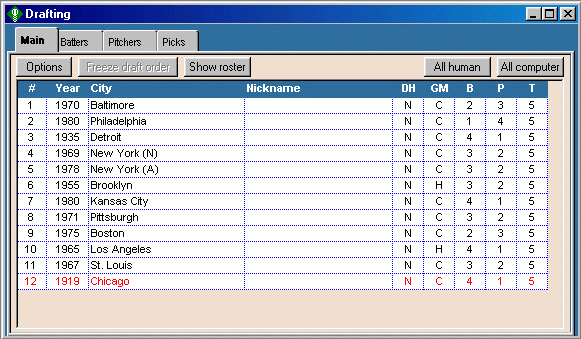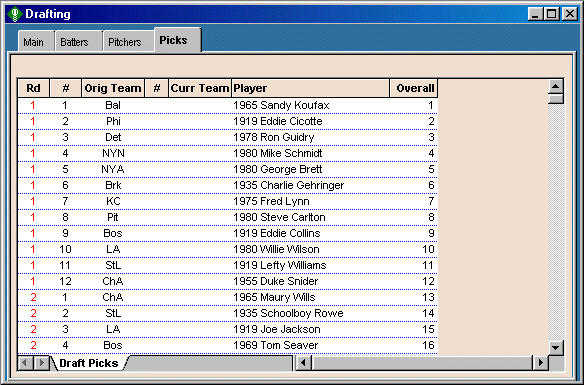Diamond Mind Draft Module
Human and Computer Drafting
Computer drafting is an important capability, but there's a lot more to the new drafting system than just that. We've created a drafting environment that allows you to:
- draft new rosters from scratch or start with partially complete rosters (such as a group of players carried over from a previous season)
- save a draft in progress and resume it later
- browse lists of free agent batters and pitchers that show a full set of statistics and ratings, sort those lists on any statistic or rating, and filter those lists based on batting and throwing hand, position, playing time and more
- add supplemental draft picks for one or more teams in any round, or delete any draft pick (to punish teams for breaking league rules, for example)
- trade draft picks
- reverse a draft pick that was made in error
- void draft picks that a team is no longer eligible to make -- because it lost the right to that pick due a rules violation, because its roster is full, or for any other reason -- and reinstate previously voided picks
- ask the computer to make one or more picks automatically
- generate a report showing all of the picks that have been made in a draft
Before we get into a more detailed description of the drafting process, it's worth noting that you can sign free agents individually without setting up a formal draft, simply by choosing the 'Sign' command from the roster window. But if you want to set up a formal draft, here's how you go about it.
First, create a draft, specifying the league or leagues that are to participate, how many rounds you want it to last, and whether the teams draft in the same order each round (1, 2, 3, ... 1, 2, 3, ...) or in reverse order every other round (1, 2, 3, ... 3, 2, 1, 1, 2, 3, ...).
When you do this, DMB generates the full list of picks that will be made in the draft (the players to be picked aren't yet known, of course). At this point, you can delete picks, add supplemental picks, and trade picks. If you change your mind about the number of rounds, you can add or delete rounds as well. You can designate which teams will use a human general manager to make its picks and which teams will have the computer GM make the decisions. And you can manually change the order in which the teams will draft or ask to have a random draft order selected for you.

Figure 1. Draft control panel (after five rounds)
The draft control panel (see Figure 1) shows the draft order, whether each team needs to draft a designated hitter, whether the team has a Human or Computer general manager to make the picks, and the number of batters, pitchers and total players on each team's roster. The team due to pick next is highlighted.
Once you're happy with these things, you can freeze the draft order and get ready to start choosing players. At this point, you can still add, delete and trade picks (though you cannot delete or trade a pick that has already been made) to reflect events that occur during the draft.

Figure 2. List of free agent batters.
A human general manager selects a player from the lists of free agent batters and pitchers. These lists use our new reporting system to provide a powerful sorting and filtering capability that makes it easy to focus your search on the types of players you're most interested in. Figure 2 shows a list of the free agent batters with at least 300 plate appearances, sorted by slugging percentage. In short, there's a ton of data at your fingertips to help you make your decisions.
But you can also invoke the computer drafting feature to make one pick, make all picks up until the next team that has a human GM, make all picks through the end of a round, or make all picks through the end of the draft. As each pick is made, the name of the player is immediately added to the draft pick report, allowing you to follow along.
When evaluating the available free agents, the computer GM looks at the needs of the team to make sure that it fills all of the roles (starting pitchers, relievers, players rated at each defensive position, and so on). And it looks at the ability of each player to help the team win in ways that go beyond hitting and pitching to include things like defense (range, error rates, throwing, holding runners), speed and bunting.
All hitters and pitchers are judged on a park- and league-neutral basis so the true ability of the player comes through. This is appropriate because Diamond Mind Baseball makes these adjustments when you play the games, and it doesn't make sense to ignore them when choosing talent in the first place.
If, for instance, a pitcher was effective despite facing the DH and/or playing in a hitters' park in real life, he may well be chosen higher in the draft than someone whose stats look better but who had a more favorable real-life environment in which to do his work.
And you might see a slugging first baseman drop lower in the draft that you might expect. Why? Because first basemen are expected to produce more offense than players at other positions, so it's harder to stand out, and because some first basemen don't supply other things -- defense, speed, bunting, the ability to play more than one position -- that make a player more valuable to a team.
We believe we have come up with a pretty comprehensive way to evaluate the overall contribution that these players make to a team, and for that reason, we think the computer GM will provide a worthy companion in your drafts, whether you're trying to out-think it or whether you're asking for its help in choosing players for your team.

Figure 3. Draft pick report.
As each pick is made by the computer manager, it also generates a new manager profile that includes this player. That way, when you view the roster for this team (which you can do at any time during or after the draft), the manager profile is already there to give you an idea of what role the computer has assigned to each player on the roster.
As part of our work on the drafting system, we've also overhauled the manager profile generator. Those of you who have played previous version of Diamond Mind Baseball know that the manager profile generator was designed to match real-life playing time as closely as possible. This doesn't make as much sense for newly-drafted rosters, since you may draft a player who played more than one position with the idea of using him in a different way than he was used in real life. The new manager profile generator looks at the talent on your roster, considers a variety of ways those players can be combined, and chooses the arrangement that produces the best chance to win.
As with any system that attempts to emulate the process that human GMs go through in something as complex as building a baseball team, there's more we can do in the future to make the computer GM even more sophisticated. At present, it has no way to know which players are considered to be future stars despite mediocre-to-awful stats in the current season. Some way to assess future value is one of several ideas that are on our list of future enhancements, but even without these improvements, we think the current version will give you a run for your money.
- Tags: About The Game